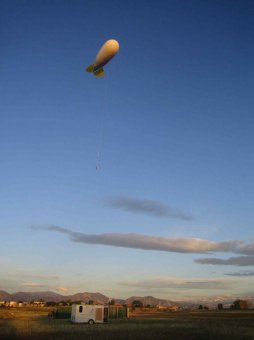
 |
| Rising above the ground in Lafayette, Colo., the blimp Tethered Lifting System (TLS) acts as a platform to take atmospheric measurements. The system was developed at the Cooperative Institute for Research in Environmental Sciences at the University of Colorado - Boulder, where a team of researchers studies the nocturnal stable boundary layer, the lowest layer of the nighttime atmosphere that extends from Earth’s surface up to a few hundred meters.
Credit: CIRES |
This Behind the Scenes article was provided to LiveScience in partnership with the National Science Foundation.
Tell Colorado scientist Yannick Meillier to go fly a kite and he just might take you seriously. A researcher at the Cooperative Institute for Research in Environmental Sciences at the University of Colorado, Boulder, Meillier is part of a team—including Ben Balsley, Rod Frehlich, and Mike Jensen—that uses kites and aerodynamic blimps, called Tethered Lifting Systems, for research.
With support from The National Science Foundation and NOAA, the team studies the nocturnal stable boundary layer, the lowest layer of the nighttime atmosphere that extends from Earth’s surface up to a few hundred meters. During the day, the boundary layer is where Earth’s weather plays out, but just what does happen there at night?
CIRES: Most scientists looking to understand Earth’s atmosphere take in situ measurements from towers or planes, but your research team has a unique way of getting instruments up into the air…
Yannick Meillier: Right, it started with Ben Balsley, a lead scientist in our group. Ben came from NOAA, where he had been using kites for research on the atmospheric electric field.
Yes, and people had given up on kites, because new technologies came out like planes and untethered weather balloons. But you can still get unique high-resolution data from kites and blimps.
What kind of advantages would a kite or blimp have over a plane or tower?
Planes travel pretty fast and they can’t fly low. We can deploy anywhere, and at any height, and the instruments can remain at one spot for hours at a time.
Towers can take continuous data, but they’re limited in height to a few hundred meters. They’re also expensive to set up and definitely not portable.
What types of measurements help you study the atmosphere?
We have two different kinds of instruments. The first kind tells us about turbulence by measuring fluctuations in temperature and horizontal windspeed 1000 times a second. The second kind is a basic meteorological payload equipped with instruments that measure wind speed and direction, temperature and altitude.
Why is turbulence important to measure?
Turbulence tells you about the mixing properties of the atmosphere, how gases, including human-made pollutants, will be transported and diffused. It’s also used to determine the structure of the atmosphere, which is between night and day.
If your goal is to study nocturnal atmospheric processes, how much of your field work takes place during the night?
All of it. The last field campaign we did, we used to meet around 7:00 pm. Sunset was around 8:30 pm. We’d work all night until sunrise.
That’s a long work shift. How do you kill time when you’re out there?
Talk, at most. You’re so busy controlling the system, worrying about the atmospheric conditions, checking the data as they come in to make sure everything is running smoothly, you don’t have time to do anything else.
So how do you get a Tethered Lifting System blimp to a field site and launch it?
Everything is packed inside a big container, like the kind that go on semi trucks. You have to take out the winch, plug in the power cord, set up the lights, and then you have to start setting up the balloon, which is partially deflated. So you bring your helium tanks and start inflating. Once it’s almost done, you start putting tails on; each one has ten lines that you have to attach to the balloon. It takes about an hour. Then you set up your computers, because we get real time feedback from our instruments.
A semi truck-size trailor? How big is your blimp?
The blimp is 25 cubic meters (about 880 cubic feet) in volume. It’s really a big balloon, but it’s not spherical. It’s aerodynamic, like a mini-zeppelin without a motor or propellers.
YOU MIGHT ALSO LIKE










